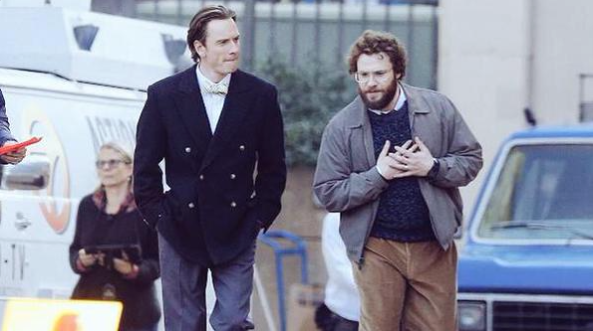I came out of Steve Jobs, the movie, feeling more like I’d watched a play than a film.
I still feel that way, six days later. This isn’t a complaint. I love theater. And Aaron Sorkin, the screenwriter, started out as a playwright; it’s something he’s good at. If theatrical structure is what appeals to him in movies, then that’s the kind of movie he should write, but it leaves the movie feeling strangely uncinematic.
Steve Jobs is a movie in three acts. Yes, I know that screenwriting theory says that every movie has three acts: the first to set up the characters, the setting and the problem; the second to show the characters attempting and failing to resolve the problem; the third to show the resolution. But Steve Jobs doesn’t do that. It really has three acts, where you can almost feel the curtain falling on one act and rising on the next. I wanted to stand up, stretch my legs, run to the restroom, get a cup of coffee — you know, the way you do during intermission at the theater. No such luck.
Each act of Steve Jobs follows the same template. Jobs is about to introduce a new product (the Macintosh, the Next workstation, the iMac). The same people (John Sculley, Steve Wozniak, Andy Hertzberg, Joanne Hoffman, Lisa Brennan-Jobs, and — in the first two acts — Chrisann Brennan) come up to him and complain, usually about the same things they were complaining about in the previous act. (Note that there’s no historical evidence that these people actually made these complaints at, or even attended, these product introductions; Sorkin is exercising dramatic license here, compressing the events and conflicts of a lifetime into a few short scenes.) Then Jobs steps out on stage and the crowd goes wild. Brief news montages are slotted in where the intermissions belong.
Sorkin finds a dramatic arc here not so much in the product introductions as in Jobs’ evolving relationship with his daughter Lisa. In the first act Jobs refuses to acknowledge that he’s her father, though you see a spark between them when she discovers MacPaint, the Mac’s innovatively mouse-driven graphics program. In the second there’s a growing bond between them, as you see Jobs fretting over his daughter’s fraught relationship with her difficult and erratic mother. In the third…well, watch the film. There’s no great revelation at the end, only a sense that Jobs has made a small emotional journey, but it’s an arc. This arc is no more supported by history than the circus of characters at the product launches. Once again, Sorkin is taking dramatic license. He’s allowed to. He’s a dramatist. (I kid, but I love Sorkin. I’ve watched the West Wing pilot at least six times now and I still cry every time.)
Is it a good movie? Well, it’s largely lacking in the signature flashiness that director Danny Boyle brought to movies like Trainspotting, Slumdog Millionaire and 127 Hours. I miss that flashiness. I still get a thrill thinking about the moment in 127 Hours when Boyle spins the camera around James Franco, trapped in a cave and enjoying his few minutes of daily sunshine while Bill Withers’ “Lovely Day” plays on the soundtrack. But this is more Sorkin’s movie than Boyle’s, auteurism be damned. (Sorkin is one of two screenwriters who in recent years have stolen the auteurist spotlight from the directors of the films they write. The other is Charlie Kaufman, who eventually turned to directing, something that Sorkin seems to have no interest in.)
Flashy or not, Steve Jobs is still immensely watchable. It’s fascinating without being entirely riveting. Sorkin’s dialog is always listenable, even when you find yourself thinking that it’s more the kind of thing Aaron Sorkin would write than the kind of thing these characters would say. And Michael Fassbender, who doesn’t look much like Jobs but manages a near perfect mimicry of his reedy voice, is one of the most watchable actors currently making films. Throw in terrific supporting performances by Kate Winslet, Seth Rogen and Jeff Daniels, each of them worthy of a Best Supporting Oscar, and the film begins to look like a small wonder of pitch-perfect narrative compression, as efficient a machine as the iPhone. It helps if you followed the events that it depicts in the computer press, but it isn’t essential. Everything that you need to know about them is in Sorkin’s script.
I’m waiting for the stage version, though. Seriously, I’d go see it, even at today’s wildly inflated ticket prices, especially if Fassbender was in it. (If you think the price of movie tickets is bad, it’s because you haven’t been to a Broadway show recently. Pay your 18 bucks for the IMAX theater and be grateful.) Steve Jobs would feel more at home under a proscenium arch than it does on the screen. It’s mostly set in three interchangeable green rooms, which would be easy enough to stage. And a live performance would give it an immediacy that it doesn’t have on film.
Don’t wait for the play before you see the movie, though. It’s worth seeing and I’m sure both Sorkin and Boyle would appreciate it if you watched in the theater. Or at least on Netflix.
